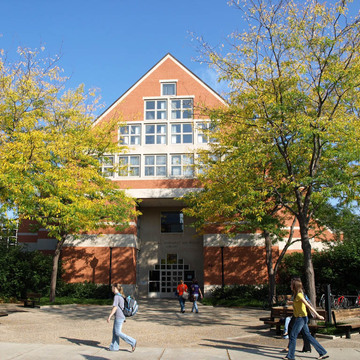You are here
Voorhees Hall (Elizabeth R. Voorhees Women's Dormitory), Hope College
The construction of this women's dormitory hall marked the admission of women to the formerly all-male liberal arts Hope College. The college was chartered in 1866 under the auspices of the Dutch Reformed Church. The marked Dutch flavor of Voorhees Hall is an outward and visible sign of the cultural ties of the people of Holland and Hope College to the Netherlands. The building has crow-step gables both in roof and dormers. Its orangish-red brick walls, which are laid in a diamond pattern in the upper story, are in strong contrast with the Bedford limestone of the foundation, quoins, voussoirs, and windowsills. The brick was manufactured locally by the Veneklasen family at the Zeeland Brick Company. The company supplied red brick for Van Raalte Hall (1902), Carnegie Hall (1906), and the President's House (1886–1892) at Hope College. Voorhees Hall currently holds faculty offices. The Gordon and Margaret Van Wylen Library (1989, Shepley, Bullfinch, Richardson, and Abbott) to the west is a Postmodern visual companion piece. Graves Hall (1892–1894; 2008–2009 restoration, Fishbeck, Thompson, Carr and Huber), a Richardsonian Romanesque chapel, library, and classroom monument in Waverly sandstone, has been adapted for use as an auditorium and classrooms.
Writing Credits
If SAH Archipedia has been useful to you, please consider supporting it.
SAH Archipedia tells the story of the United States through its buildings, landscapes, and cities. This freely available resource empowers the public with authoritative knowledge that deepens their understanding and appreciation of the built environment. But the Society of Architectural Historians, which created SAH Archipedia with University of Virginia Press, needs your support to maintain the high-caliber research, writing, photography, cartography, editing, design, and programming that make SAH Archipedia a trusted online resource available to all who value the history of place, heritage tourism, and learning.















